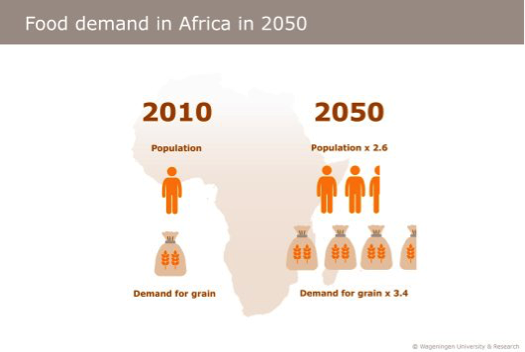 Can Tanzania feed itself by 2050? Estimating cereal self-sufficiency to 2050
Can Tanzania feed itself by 2050? Estimating cereal self-sufficiency to 2050JOACHIM H.J.R. MAKOI, MARTIN K. VAN ITTERSUM, KEITH D. WIEBE
RESEARCH SUMMARY
2017, 4 pages
 The study reveals the enormous challenge of keeping
up with anticipated increases in future cereal
demand. Full yield gap closure on existing cereal
land is needed to roughly maintain today’s selfsufficiency.
The study reveals the enormous challenge of keeping
up with anticipated increases in future cereal
demand. Full yield gap closure on existing cereal
land is needed to roughly maintain today’s selfsufficiency.Closing the yield gaps implies an enormous break from observed historic trends in annual yield increases. It requires use of improved cultivars, hybrids, and seed, coupled with increased use of fertilizers, modern pest management practices, and good agronomy.
Accelerated intensification will require greater investment in research and development (R and D) in both public and private sectors. This investment is needed now, and will be even more urgent under future climate change.
- Investments in agricultural R and D must be matched by supportive policies and public finance for improved transport and communication, market infrastructure, credit, insurance, and improved land entitlements.
- In the study’s calculations, rainfed cereal production is the dominant form of production. Tanzania’s government may also opt to invest in irrigation (that is, climate resilient infrastructure), which would lead to higher potential yields and more scope for production increases.
- Further, an increase in intensity of cropping systems (growing more than one crop per 12 months) may help Tanzania keep up with the future increase in demand.
This note is based on research performed in the context of the Global Yield Gap Atlas (GYGA) project (www.yieldgap.org) and supported by the Bill & Melinda Gates Foundation, the Robert B. Daugherty Water for Food Institute at the University of Nebraska– Lincoln, and Wageningen University & Research (the Netherlands). Research conducted using the International Food Policy Research Institute’s IMPACT model was supported by the CGIAR Research Program on Policies, Institutions, and Markets (PIM), the CGIAR Research Program on Climate Change, Agriculture and Food Security (CCAFS), and the Bill & Melinda Gates Foundation.

No comments:
Post a Comment